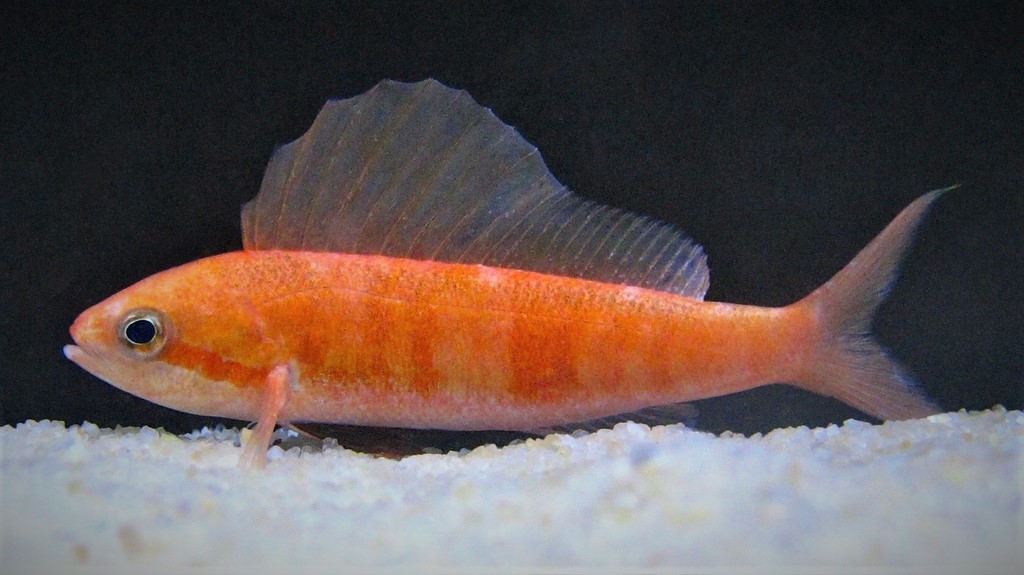RABAULICHTHYS SQUIREI - (RANDALL & WALSH, 2010)
Picture courtesy of: Aquarium Fish (Link)
Actinopterygii (Gigaclass) > Actinopteri (Class) > Teleostei (Subclass) > Perciformes (Order) > Percoidei (Suborder) > Anthiadidae (Family) > Rabaulichthys (Genus)
Southern sailfin anthias, Coral sea sailfin anthias,
Description
Dorsal spines (total): 10; Dorsal soft rays (total): 16; Anal spines: 3; Anal soft rays: 7; Vertebrae: 26; Pectoral fin rays: 19-21 (rarely: 21); Lateral line scales: 51-59; Gill rakers: 9 + 23-24; Body depth: 23.8-25.3 % SL; Head length: 28.5-30.6 % HL; Snout length: 6.8-7.4 % SL; Longest dorsal spine of mature males: 28.7-31.3 % SL; Caudal fin of mature males: 31.8-35.8 % SL. Max. length: 6.2 cm SL. Depth range: 6 - 54 m.
Color
Pale red with pale scale centres, a series of indistinct reddish-brown bars of unequal width along the side (bars without pale margins); An oblique, pale-edged, brownish orange band from snout through eye and across cheek; Pelvic fins black with red rays; Remaining fins pink to yellowish; No black band in soft portion of dorsal fin.
Etymology
Rabaulichthys: named for Rabaul (New Britain Island, Bismarck Archipelago, Papua New Guinea), town just west of type locality of Rabaulichthys altipinnis + from Greek, -ichthys = fish.
squirei: in honor of Cadel Squire, marine aquarium-fish exporter (Queensland, Australia), who collected most of the type specimens.
Original description: Rabaulichthys squirei Randall & Walsh, 2010 - Type locality: Flinders Reef, north end, 17°24'01"S, 148°25'03"E, Coral Sea, depth: 54 meters, barrier net, T. Bennett, 1/10/2007.
Distribution
Southwestern Pacific: Coral Sea off Queensland, Australia and New Caledonia.
Biology
Found over open stretches of coral rubble, and therefore avoid the many predators of coral reefs; Form small aggregations that feed on zooplankton above the substratum. Immature males and females of Rabaulichthys squirei are morphologically indistinguishable, but black pigment develops in the pelvic fins of the males before the dorsal spines become longer. Aquarium fish (rare).
Last update: 17, March 2024
Actinopterygii (Gigaclass) > Actinopteri (Class) > Teleostei (Subclass) > Perciformes (Order) > Percoidei (Suborder) > Anthiadidae (Family) > Rabaulichthys (Genus)
Southern sailfin anthias, Coral sea sailfin anthias,
Description
Dorsal spines (total): 10; Dorsal soft rays (total): 16; Anal spines: 3; Anal soft rays: 7; Vertebrae: 26; Pectoral fin rays: 19-21 (rarely: 21); Lateral line scales: 51-59; Gill rakers: 9 + 23-24; Body depth: 23.8-25.3 % SL; Head length: 28.5-30.6 % HL; Snout length: 6.8-7.4 % SL; Longest dorsal spine of mature males: 28.7-31.3 % SL; Caudal fin of mature males: 31.8-35.8 % SL. Max. length: 6.2 cm SL. Depth range: 6 - 54 m.
Color
Pale red with pale scale centres, a series of indistinct reddish-brown bars of unequal width along the side (bars without pale margins); An oblique, pale-edged, brownish orange band from snout through eye and across cheek; Pelvic fins black with red rays; Remaining fins pink to yellowish; No black band in soft portion of dorsal fin.
Etymology
Rabaulichthys: named for Rabaul (New Britain Island, Bismarck Archipelago, Papua New Guinea), town just west of type locality of Rabaulichthys altipinnis + from Greek, -ichthys = fish.
squirei: in honor of Cadel Squire, marine aquarium-fish exporter (Queensland, Australia), who collected most of the type specimens.
Original description: Rabaulichthys squirei Randall & Walsh, 2010 - Type locality: Flinders Reef, north end, 17°24'01"S, 148°25'03"E, Coral Sea, depth: 54 meters, barrier net, T. Bennett, 1/10/2007.
Distribution
Southwestern Pacific: Coral Sea off Queensland, Australia and New Caledonia.
Biology
Found over open stretches of coral rubble, and therefore avoid the many predators of coral reefs; Form small aggregations that feed on zooplankton above the substratum. Immature males and females of Rabaulichthys squirei are morphologically indistinguishable, but black pigment develops in the pelvic fins of the males before the dorsal spines become longer. Aquarium fish (rare).
Last update: 17, March 2024
